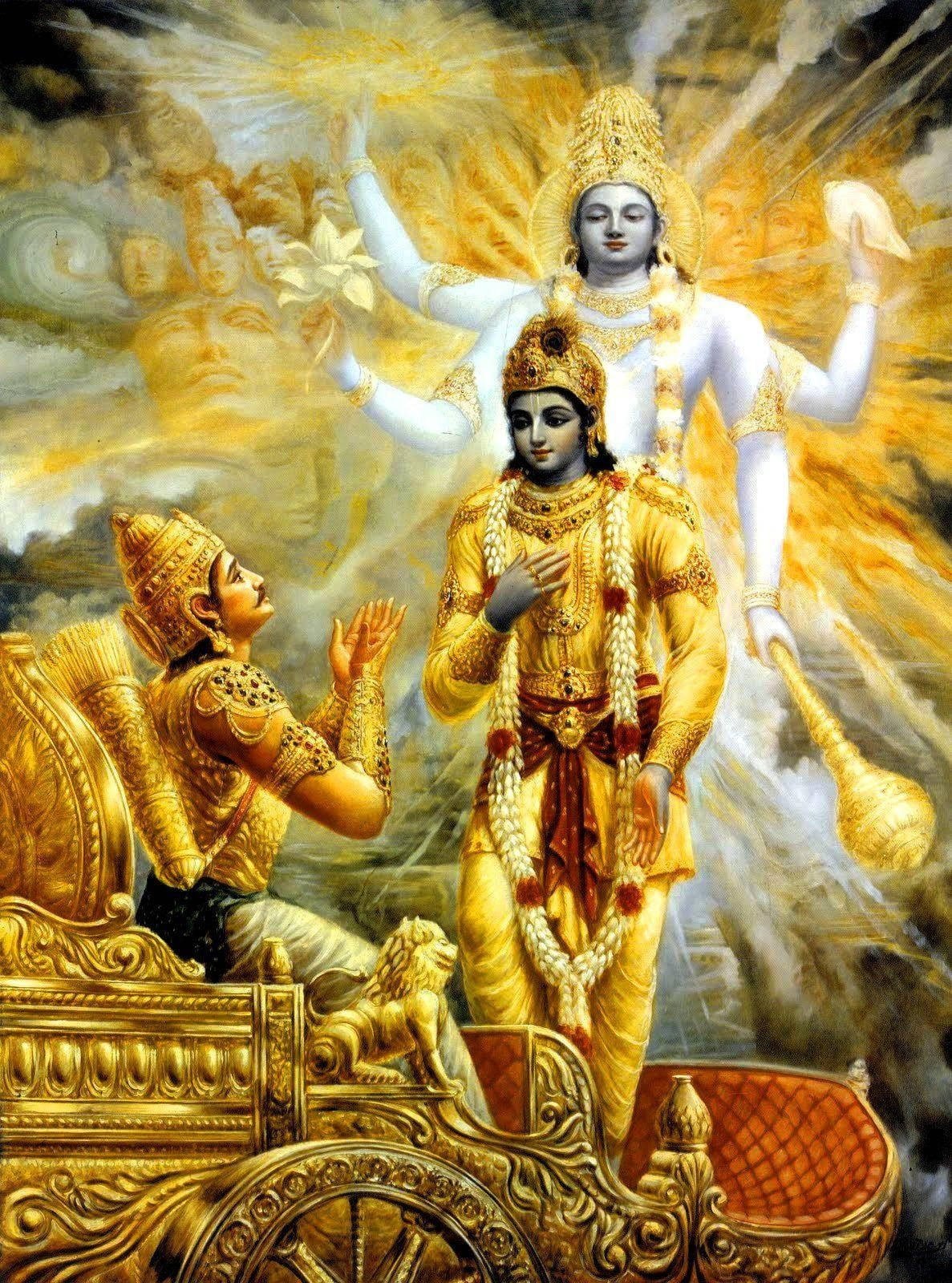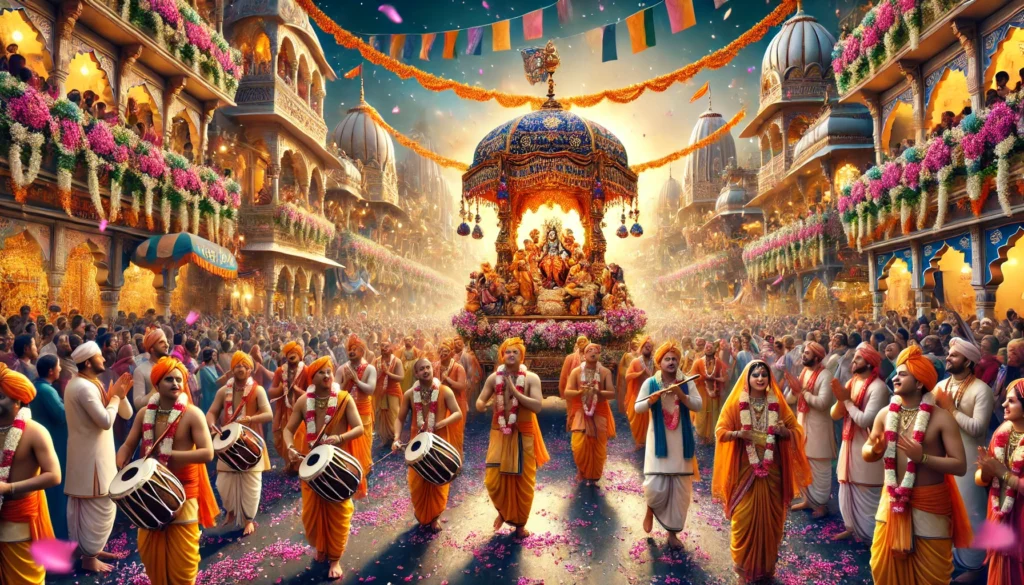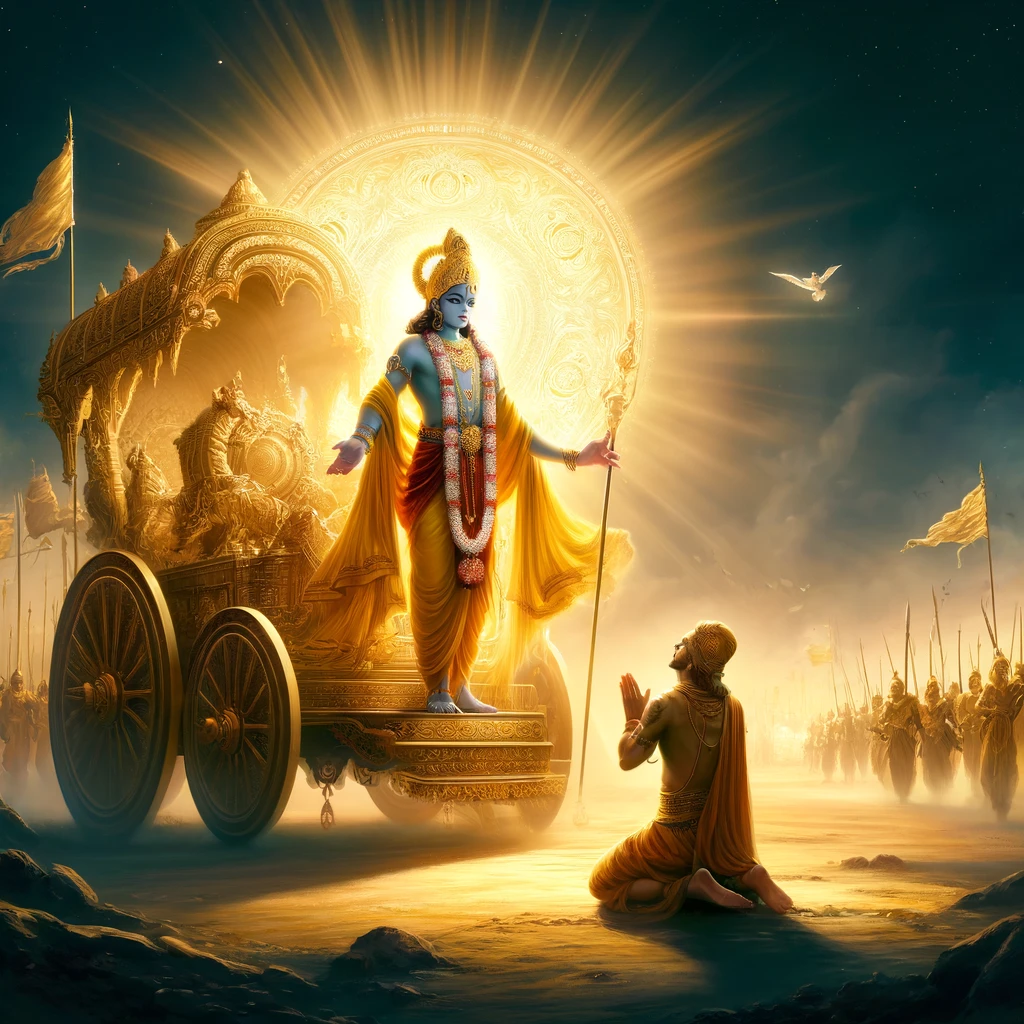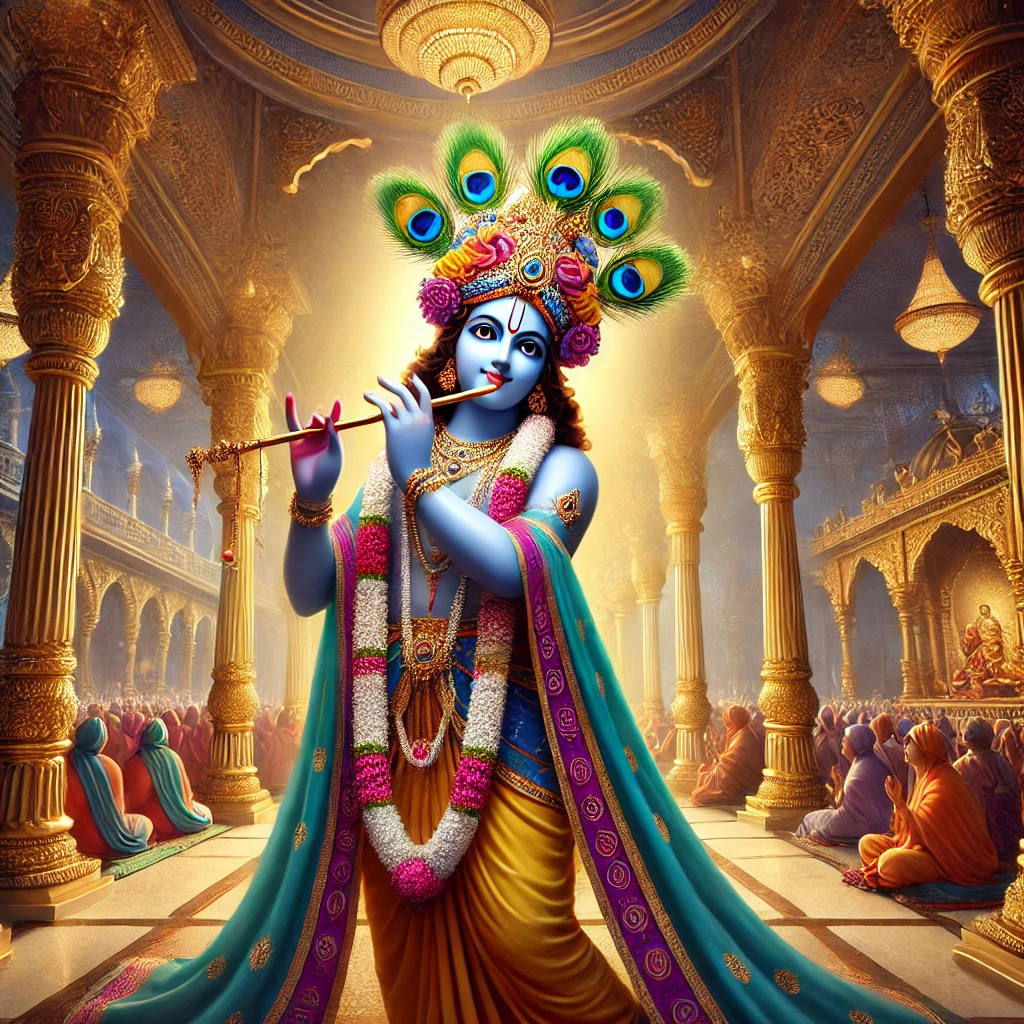Gist of Bhagavad Gita
The Bhagavad Gita is a special book that helps people understand life and find peace. It is a conversation between Lord Krishna, who is the Supreme God, and Arjuna, a warrior prince. This talk happens on a battlefield called Kurukshetra, right before a big war. The Gita answers deep questions about who we are, what we should do, and how we can be free from suffering. It is a guide for anyone who wants to grow spiritually and live a better life.
Background and Context
The Bhagavad Gita is part of a long story called the Mahabharata, an ancient tale from India. The Mahabharata is about a war between two families: the Pandavas and the Kauravas. Arjuna is a prince from the Pandavas. He is a skilled fighter, but when the war is about to start, he gets into emotional turmoil. He sees his relatives, friends, and teachers on the other side and does not want to fight them. He feels stuck and does not know what to do.
At this moment, Arjuna turns to Krishna, who is driving his chariot. Krishna is not just a friend; he is God himself. He starts teaching Arjuna about life, the soul, and the right way to act. This teaching becomes the Bhagavad Gita, which means “The Song of God.” The battlefield is a real place, but it also stands for the struggles we all face in life. The Gita shows how to deal with tough choices and find clarity.
Long ago, Krishna first told these teachings to the sun-god, who passed them down through many people. But over time, the message got lost or mixed up. So, Krishna speaks it again to Arjuna to set things right. This makes the Gita fresh and important for everyone, even today.
Introduction and Purpose
The Bhagavad Gita is called the “Gitopanisad” because it holds the most important wisdom from the Vedas, which are old holy books from India. It is one of the key Upanishads, special texts that explain deep truths. The Gita’s main goal is to help people realize who they really are and how to be free from the cycle of birth and death. It teaches that Krishna is the Supreme God, the one who made everything, and that serving him is the way to true happiness.
Some people have written about the Gita before, but they often added their own ideas, which changed its real meaning. The Gita should be taken as it is, straight from Krishna, without mixing in other thoughts. Great teachers like Sankaracarya and Ramanujacarya agree that Krishna is the Supreme Personality of Godhead. The Gita is especially for people who want to love and serve Krishna, like Arjuna, who accepts Krishna as the highest truth and his best friend. This friendship shows how we can connect with God in a simple, loving way.
Core Themes of the Bhagavad Gita
The Bhagavad Gita covers many big ideas that help us live better and understand the world. Here are the main teachings, explained step by step.
The Gita teaches that we are not just our bodies. Our bodies are temporary—they are born, grow old, and die. But inside each of us is a soul that never dies. In Chapter 2, Verse 20, Krishna says: "For the soul there is neither birth nor death at any time. He has not come into being, does not come into being, and will not come into being. He is unborn, eternal, ever-existing and primeval. He is not slain when the body is slain." This means our true self is the soul, not the body we see in the mirror. The soul is eternal, strong, and cannot be hurt or destroyed.
Krishna also explains who he is. In Chapter 7, Verse 7, he says: "O conqueror of wealth, there is no truth superior to Me. Everything rests upon Me, as pearls are strung on a thread." This shows that Krishna is the Supreme God, the one who holds everything together. He is the start of all creation and the most important truth. Knowing this helps us see that our soul belongs with Krishna, and our purpose is to return to him.
The Gita tells us to do our duties but not to worry about what we get out of them. Arjuna’s duty is to fight as a warrior, but he is afraid and unsure. Krishna helps him by saying, in Chapter 2, Verse 47: "You have a right to perform your prescribed duty, but you are not entitled to the fruits of action. Never consider yourself the cause of the results of your activities, and never be attached to not doing your duty." This means we should do our work—like taking care of our family, going to our job, or helping others—without being attached to success or failure. We should not do it for fame, power, or prestige, but because it is the duty assigned to us. All the effort and results must be given back to Krishna. We should not get attached to any kind of success or failure that comes from performing our duty. All we need to care about is the duty itself, our actions, and our surrender to Krishna while doing these duties. This is the only way our actions do not produce reactions or karma. If we do our duties as service to God, our actions get purified, and they do not produce any karma. That is the only way to get out of the cycle of birth and death.
This idea is called "karma yoga." It is about acting for the sake of duty, not for selfish reasons, and giving our efforts to Krishna. In Chapters 3 and 5, Krishna explains that when we work this way, we stay free from the ups and downs of life. We do not get trapped by good or bad outcomes, and we grow spiritually and closer to Krishna.
The Gita talks about different ways to grow spiritually and reach Krishna. These paths are:
Karma Yoga: Doing your duty according to your varna and ashram, while being fully surrendered to Krishna. Do it as a duty and do not get attached to success or failure. By doing this, our actions do not produce karma.
Jnana Yoga: This means studying the scriptures very carefully and understanding the difference between the body and the soul in an analytical way. Then, develop detachment from the body.
Dhyana Yoga: Meditating and following the eight limbs of Ashtanga Yoga to realize the God who is within the heart. This is done by restraining all the senses and doing yoga and asanas to slowly turn oneself inward and focus on the Vishnu form of the Lord who resides in the heart.
These paths are good, but the Gita says the best way is bhakti yoga, which means loving and serving Krishna. In Chapter 12, Arjuna asks Krishna which is better: loving Krishna directly or meditating on God without a form. Krishna answers in Verse 2: "Those who fix their minds on My personal form and are always engaged in worshiping Me with great and transcendental faith are considered by Me to be most perfect.." This shows that bhakti yoga is the easiest and strongest path.
In Chapter 6, Krishna says meditation is hard for most people today because it takes a lot of effort and focus. But bhakti yoga is simpler—you just think of Krishna, pray to him, and try to make him happy. In Chapter 9, Verse 34, Krishna says: "Engage your mind always in thinking of Me, become My devotee, offer obeisances to Me and worship Me. Being completely absorbed in Me, surely you will come to Me." This promise makes bhakti yoga perfect for anyone who wants to connect with Krishna.
The Gita explains that the world works under three qualities, or "modes," of nature:
- Goodness: This is calm, clear, and peaceful.
- Passion: This is active, full of wants, and restless.
- Ignorance: This is dark, lazy, and confused.
These modes are all around us—in food, in people, in everything. They keep our souls tied to the material world, making us go through birth and death again and again. In Chapter 14, Krishna teaches how these modes control us and trap us.
But there is a way out. In Chapter 14, Verse 26, Krishna says: "One who engages in full devotional service, unfailing in all circumstances, at once transcends the modes of material nature and thus comes to the level of Brahman." Brahman is the spiritual level, a place of pure happiness beyond the material world. By loving Krishna and serving him, we can break free from these modes and stop the cycle of suffering.
5. Surrender to Krishna
The biggest lesson in the Gita comes at the end, in Chapter 18, Verse 66. Krishna says: "Abandon all varieties of religion and just surrender unto Me. I shall deliver you from all sinful reactions. Do not fear." This is the heart of the Gita. Surrendering to Krishna means trusting him completely, loving him, and letting him guide us.
Krishna does not care if we have made mistakes. If we turn to him with faith, he takes away all our troubles. In Chapters 9 and 12, he shares secret knowledge with Arjuna, showing that bhakti—loving devotion—is better than any other way, like hard meditation or chasing after rewards. When we surrender, Krishna protects us and brings us to him. This makes us perfect and happy forever.
Accessibility and Universality
The Bhagavad Gita is for everyone. You do not need to be special, smart, or from a certain place to follow it. In Chapter 18, Krishna shows that his teachings work for all people, no matter who they are. Bhakti yoga is open to anyone who wants to love Krishna. You can be at home, at work, or anywhere, and still follow this path.
How to live Bhagvad Gita?
The Bhagavad Gita advises that Bhakti is the most effective way to attain God, or Krishna. However, it is equally important to understand how to practice Bhakti in the present day and age. In today’s world, the best way to perform Bhakti is by chanting the Hare Krishna Mahamantra: “Hare Krishna, Hare Krishna, Krishna Krishna, Hare Hare, Hare Rama, Hare Rama, Rama Rama, Hare Hare.” Additionally, one should follow the four regulative principles: no meat-eating, no intoxication, no gambling, and no illicit sex.
The food we consume should also be sanctified. This means preparing a vegetarian meal with care, offering it to Krishna first, and then partaking of it as prasadam. Other essential practices include reading the Bhagavad Gita and Srimad Bhagavatam, singing kirtan, and staying in the company of like-minded devotees who worship Krishna. These are practical ways to engage in Bhakti. By following these principles in the age of Kali Yuga, we can attain the Supreme Personality of Godhead, Krishna.
Conclusion
The Bhagavad Gita teaches us that we are eternal souls, not just bodies that die. Our real job is to know Krishna, the Supreme God, and serve him with love. By doing our duties without attachment, following bhakti yoga, and surrendering to Krishna, we can leave the material world behind and find true peace.
The Gita’s lessons are clear: think of Krishna, love him, and trust him. This path is the best way to be free and happy. It works for all people, everywhere, at any time. The Bhagavad Gita is a timeless book that shows us how to live well and return to Krishna, our true home.





